Pro athletes rely on seven key recovery systems to maintain peak performance: Normatec compression boots for enhanced circulation, advanced hydrotherapy treatments for inflammation reduction, whole-body cryotherapy chambers for hormone balance, red light therapy panels for cellular repair, Theragun percussion massagers for muscle tension relief, Firefly recovery devices for blood flow stimulation, and customized active recovery protocols. You'll find these cutting-edge tools in elite training facilities worldwide, backed by scientific research and proven results. Each system offers unique benefits that work together to speed healing, reduce soreness, and optimize athletic performance. Discover how these powerful recovery methods can transform your training routine.
What Pro Athletes Want
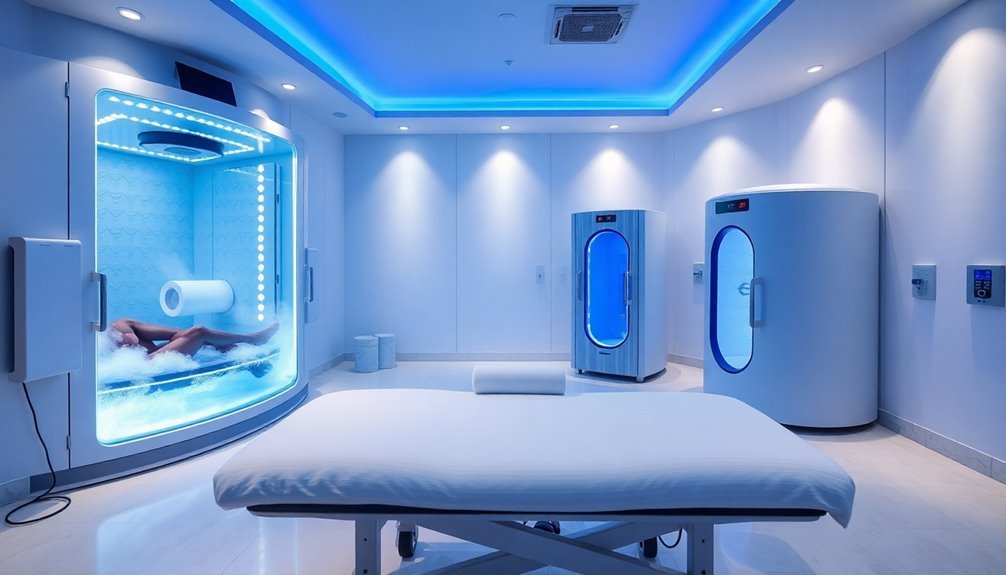
Professional athletes demand thorough recovery systems that address both physical and mental well-being. They're looking for extensive solutions that combine immediate post-training care with long-term recovery strategies. You'll find that most athletes prioritize customizable recovery plans that adapt to their specific needs and training intensities.
What sets pro athletes apart is their insistence on multi-faceted recovery approaches. They want access to advanced tools like Normatec compression boots and Game Ready units, alongside traditional methods such as ice baths and massage therapy. Athletes often incorporate hydrotherapy treatments to boost their endurance performance and reduce inflammation.
They're particularly focused on sleep quality, often aiming for 8-10 hours per night, supplemented with strategic napping during intense training periods.
Active recovery plays a vital role in what athletes seek. They're incorporating low-intensity activities like easy bike rides and light jogs into their routines.
Most importantly, they want recovery systems that can be monitored and adjusted based on their performance data and feedback. You'll see them combining physical therapy, mental wellness practices, and proper nutrition into their daily routines, ensuring they maintain peak performance levels while preventing potential injuries.
Red Light Benefits for Recovery
Red light therapy will supercharge your muscle recovery by increasing ATP production and promoting faster tissue repair at the cellular level.
You'll experience reduced inflammation, decreased muscle soreness, and accelerated healing times thanks to improved blood flow and enhanced oxygen delivery to damaged tissues.
Your athletic performance will improve as the therapy strengthens muscle tissue, increases endurance, and helps prevent future injuries through its thorough healing effects. The therapy's ability to stimulate mitochondrial activity enhances cellular energy production for optimal muscle function and recovery.
Muscle Recovery Science Benefits
When it comes to cutting-edge recovery methods, light therapy has emerged as a game-changing solution for athletes seeking faster muscle recovery and enhanced performance. Research shows that red light therapy substantially reduces recovery time, with athletes returning to play in just 9.6 days compared to the expected 19.23 days.
You'll experience multiple benefits when integrating red light therapy into your training routine. The treatment reduces muscle soreness and fatigue by enhancing blood circulation, delivering essential oxygen and nutrients to damaged tissues. Athletes who use this therapy also experience better muscle tone during their training periods.
It's particularly effective at decreasing inflammation and accelerating cell regeneration, which helps repair damaged muscle fibers more efficiently.
What makes red light therapy especially valuable is its versatility. You can use it both before and after workouts – pre-exercise sessions prepare your muscles for intense training, while post-workout treatments speed up recovery and reduce inflammation.
The non-invasive nature of the therapy means you can easily incorporate it into your daily routine, whether through full-body treatments at a facility or using home devices.
The extensive benefits extend beyond just muscle recovery, supporting your overall athletic performance by improving strength, endurance, and oxygen uptake while helping manage pain and accelerate injury rehabilitation.
Athletic Performance Enhancement Effects
Athletes seeking a competitive edge are discovering remarkable performance enhancements through red light therapy's scientifically proven benefits. When you expose your body to red light therapy, it penetrates your skin and stimulates your cells' mitochondria, boosting ATP production for enhanced muscle function and overall performance.
You'll experience significant improvements in muscle gain, strength, and endurance – up to three times more than without treatment. The therapy's non-invasive nature means you can safely incorporate it into your daily training routine without worrying about adverse effects. Regular sessions during your routine promote better sleep quality by regulating your circadian rhythm.
You'll notice faster recovery times, reduced muscle fatigue, and improved flexibility as the treatment accelerates healing and reduces inflammation.
Before or after your workouts, a 10-20 minute session can make a substantial difference in your athletic performance. You'll benefit from enhanced circulation, better oxygen uptake, and decreased body fat.
The therapy doesn't just boost physical performance – it also improves your mental focus and mood by increasing serotonin and dopamine production. Whether you're using handheld devices for targeted treatment or full-body panels, you'll find red light therapy's extensive benefits support both immediate performance gains and long-term athletic development.
Post-Workout Healing Advantages
Designed to revolutionize post-workout recovery, light therapy offers professional athletes a powerful healing advantage that transforms how quickly their bodies bounce back from intense training.
When you expose your muscles to red light therapy after an intense workout, you'll trigger multiple healing responses that accelerate recovery.
You'll experience reduced inflammation and muscle soreness as the therapy inhibits enzymes responsible for post-workout pain. The increased blood flow and enhanced circulation deliver more oxygen and nutrients to your muscles, speeding up the repair process.
Additionally, you'll benefit from boosted mitochondrial function, which increases ATP production and provides your muscles with the energy they need to recover. Athletes can expect optimal results with 3-5 weekly sessions of consistent treatment.
The therapy's impact on your circadian rhythm helps enhance your sleep patterns, a vital component of muscle recovery. You'll also notice improvements in tissue repair thanks to increased collagen production.
For best results, you'll want to incorporate red light therapy consistently into your post-workout routine. The treatment reduces delayed onset muscle soreness (DOMS), allowing you to maintain your training schedule without extended downtime.
It's particularly effective when used immediately after intense training sessions to jumpstart the healing process.
Top Recovery Systems Today
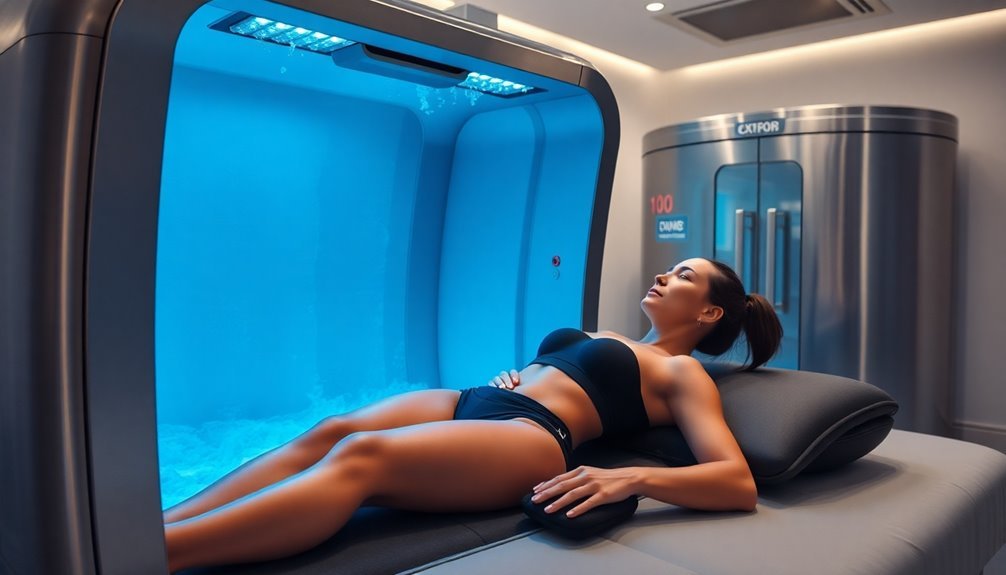
Five cutting-edge recovery systems dominate today's professional sports landscape, each offering unique benefits for elite athletes.
The Theragun G3 Percussion Massager leads the pack with its powerful 40-pound force that targets deep muscle tension. The machine pulses 40 times per second for optimal muscle relief. The NormaTec Full Body Recovery System's compression technology effectively boosts circulation and reduces lactate buildup, while the GameReady Ice Therapy Machine combines cold therapy with compression for accelerated healing.
When you're looking at portable solutions, both the Aquilo Recovery Pants and Rapid Reboot Compression Boots offer dynamic recovery options that you can use anywhere. These systems help flush out metabolic waste while promoting healthy blood flow throughout your muscles.
- The Theragun's percussion therapy penetrates deeper than traditional massage, helping you bounce back faster between training sessions.
- NormaTec's sequential compression mimics natural muscle pump action, enhancing recovery while you rest.
- GameReady's combination of ice and compression provides targeted relief to specific body areas.
- Portable systems like Aquilo and Rapid Reboot let you maintain your recovery routine even during travel.
You'll find these systems integrated into most professional teams' recovery protocols, often used alongside active recovery techniques and proper nutrition timing.
Science Behind Light Therapy
Light therapy's effectiveness stems from how different wavelengths penetrate your body's tissues at varying depths, with red and infrared light reaching deep into joints and muscles.
When these therapeutic wavelengths hit your cells, they spark a series of healing responses, including increased cellular energy production and enhanced collagen synthesis.
The specific wavelengths used in professional light therapy systems target cytochrome C oxidase in your cells, triggering natural repair mechanisms that reduce inflammation and speed up recovery. Fibroblast cells actively utilize this targeted light energy to produce new collagen and elastin for optimal tissue repair.
Mechanisms of Light Penetration
In accordance with scientific research, the mechanisms of light penetration involve complex interactions between photons and living tissue. When you're using light therapy devices, near-infrared light (600-980 nm) targets cytochrome C oxidase in your cells' mitochondria, initiating a process called photobiomodulation. This interaction triggers ATP production, which is essential for cellular energy and repair. Pulsed light delivery has shown superior penetration compared to continuous wave applications.
Your body's tissues present various barriers to light penetration. The skull and scalp substantially reduce light energy, with studies showing that only a small fraction reaches deep targets. That's why you'll need high-powered devices with specific wavelengths (810 nm and 980 nm) for effective treatment.
- Light penetrates through your skin and encounters multiple tissue layers
- Each layer (skin, bone, connective tissue) absorbs and scatters light differently
- Only 11.4% to 40.1% of light penetrates through skull tissue, depending on thickness
- Longer exposure times won't increase penetration depth due to scatter and refraction
Understanding these mechanisms explains why professional athletes rely on high-powered devices rather than consumer-grade LED systems, which typically can't penetrate beyond 3mm into human skin.
Healing Wavelength Benefits
Building on our understanding of light penetration, specific wavelengths offer distinct therapeutic benefits for athletes and medical patients alike. Red light therapy, particularly in the 630-700 nm range, works through photobiomodulation to transform light energy into cellular energy, enhancing your body's natural recovery processes.
You'll find that these healing wavelengths penetrate at different depths to target specific issues. The 660 nm wavelength excels at treating surface-level concerns like skin health and superficial injuries, while the 850 nm near-infrared light reaches deeper tissues for muscle and joint recovery.
When you're exposed to these therapeutic wavelengths, your cells' mitochondria become more efficient at producing ATP, accelerating tissue repair and reducing inflammation.
For athletes, this means you'll experience faster recovery times, enhanced muscle function, and improved performance. The therapy's versatility extends beyond sports medicine, as it's proven effective for pain management, wound healing, and even hair growth.
Clinical trials support these benefits, showing that proper dosing of LED-based red light therapy can substantially reduce recovery time from injuries while providing a drug-free alternative to traditional pain management methods.
Choosing Your Recovery Device
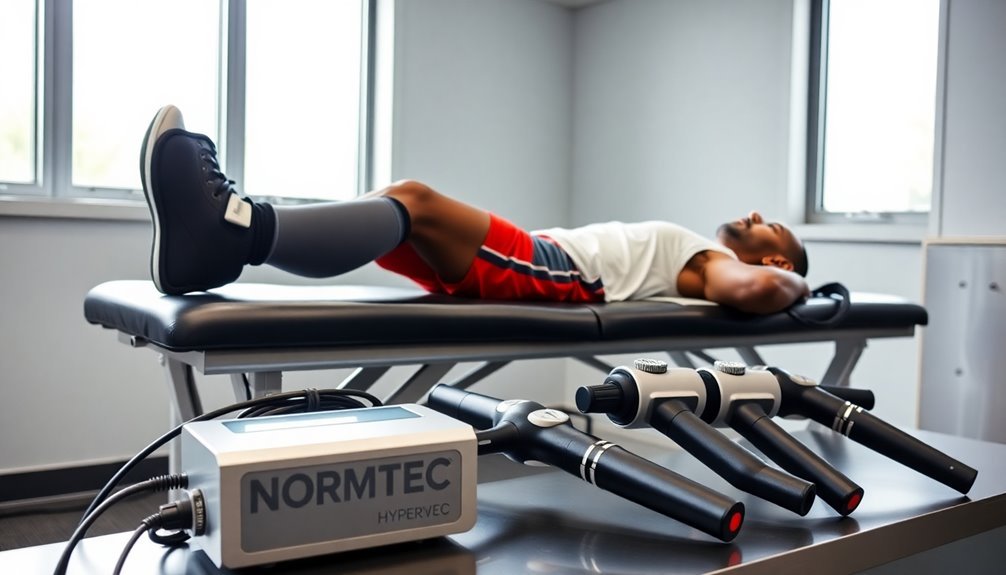
When selecting a recovery device for professional athletic training, several key features deserve careful consideration. You'll want to evaluate compression ranges, portability, battery life, and customization options to match your specific recovery needs.
The latest recovery boots offer varying pressure levels, from Therabody's 20-100mmHg range to MyoMaster's impressive 30-250mmHg capability.
- Focus on portability if you're frequently traveling – Therabody's wireless JetBoots offer unmatched mobility with their internal pump design.
- Consider battery life requirements – devices range from three to five hours, with Recovapro Air leading at five hours of continuous use, although this specific point seems to be an error as the Recovapro Air is noted to have up to 99 minutes in a single session, not five hours.
- Evaluate app integration needs – Therabody and Hyperice offer smart features through dedicated apps.
- Assess session flexibility – some devices offer pre-programmed options while others allow complete customization.
Your training schedule and recovery routine should guide your choice. If you need targeted therapy, Hyperice's ZoneBoost technology might be ideal.
For maximum pressure customization, MyoMaster's 11 settings could be your best option.
Wireless options like Therabody's JetBoots offer convenience, while tethered systems often provide more extensive programs and longer sessions.
Common Recovery Mistakes
Professional athletes commonly make critical recovery mistakes that can substantially impact their performance and rehabilitation success. One of the most significant errors is rushing back to training before the body has adequately healed, often leading to reinjury or prolonged recovery times.
You'll also find athletes neglecting the fundamentals, particularly sleep and nutrition, while focusing too heavily on advanced recovery techniques.
A major pitfall is failing to develop a thorough recovery plan that addresses your individual needs. You're at risk when you don't properly assess your recovery requirements or adjust your strategy based on training phases and competition schedules.
Many athletes skip physical therapy sessions and ignore professional advice, compromising their rehabilitation progress.
Don't overlook the importance of proper conditioning before returning to full activity. You'll need to focus on total body rehabilitation, not just the injured area.
Make sure you're following appropriate exercise progressions and avoiding overtraining. Remember that recovery isn't just physical – you must account for mental stress and cognitive load.
If you're not implementing proper cool-down routines and stretching protocols, you're missing essential components of effective recovery management.
Research-Backed Results
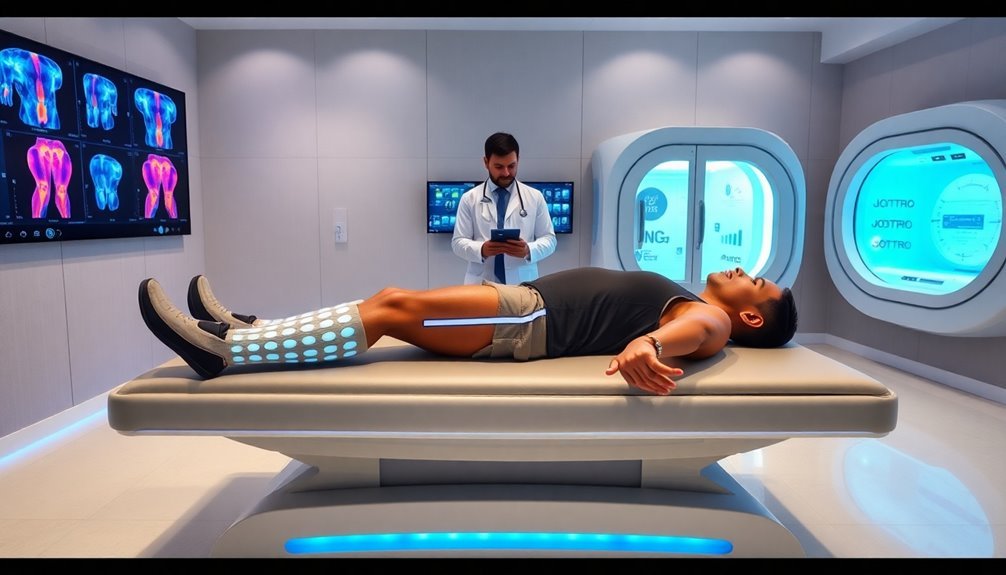
Scientific studies have consistently proven that proper recovery techniques can cut your healing time in half and boost performance by up to 30%.
You'll find that sleep quality improves athletic performance by 20-30%, while proper nutrition combined with hydration reduces injury risk by 25%.
Research also confirms that combining multiple recovery methods, such as compression garments with cold water immersion, leads to notably better outcomes than using single techniques alone.
Clinical Studies Show Benefits
Clinical research breakthroughs have consistently demonstrated the effectiveness of modern recovery techniques for athletes. You'll find that studies specifically highlight how cold therapy and whole-body cryotherapy substantially reduce muscle soreness and inflammation, while heat therapy enhances blood flow and metabolic recovery.
The research points to active recovery sessions of 6-10 minutes showing reliable performance improvements.
- Cold therapy disables connections with sensory receptors and proprioceptors, leading to reduced muscle tension and faster recovery from DOMS.
- Heat therapy increases tissue temperature and metabolism, helping your body bounce back from metabolic fatigue more efficiently.
- Active recovery techniques, including foam rolling and massage, boost neuromuscular recovery and performance outcomes.
- Multiple recovery interventions used together deliver better results than single modalities.
Studies reveal that top performers consistently use more recovery strategies than their competitors. You'll notice that female athletes typically implement a wider variety of recovery techniques than male athletes.
While age tends to correlate with decreased use of recovery methods, the evidence clearly shows that combining multiple recovery approaches leads to superior outcomes in both training and competition.
Recovery Time Data Analysis
When analyzing recovery patterns in elite athletes, data-driven insights reveal compelling trends through advanced monitoring techniques. Studies show that top performers maintain ideal recovery through measurable metrics, with resting heart rates averaging 37.8 and sleep duration hitting 8.39 hours consistently.
Heart Rate Variability (HRV) and nocturnal RMSSD measurements provide reliable indicators of recovery status. Athletes with higher nocturnal RMSSD ranges (62-127) demonstrate better recovery outcomes, while their recovery index typically falls between 100-270.
Machine learning algorithms now help predict your recovery status by analyzing these key variables alongside perceived soreness and sleep quality.
To optimize your recovery, you'll need to monitor both internal and external factors. This means tracking your training load, stress levels, and nutrition while using real-time data from wearable devices.
You can make informed decisions about when to push harder or implement de-loading phases based on your personal recovery metrics. Remember that simpler models focusing on key variables like sleep quality and soreness can be just as effective as complex analyses in predicting your recovery status.
Performance Enhancement Metrics
Building on these recovery insights, modern performance metrics now offer unprecedented precision in tracking athletic development.
You'll find that today's athletes rely on data-driven decisions to optimize their training and recovery protocols. By incorporating both objective measurements and subjective feedback, you're able to create a thorough picture of athletic performance and recovery needs.
- Heart Rate Variability (HRV): Track your autonomic nervous system's response to training load, helping you determine when to push harder or scale back.
- Lactate Threshold: Monitor your body's ability to clear lactic acid during intense exercise, indicating your current fitness level and recovery status.
- VO2 Max: Measure your maximum oxygen uptake capacity to gauge cardiovascular fitness and endurance potential.
- One-Rep Max (1RM): Assess your strength levels across different exercises to track progress and prevent overtraining.
You'll want to combine these metrics with wearable technology and biometric sensors for real-time feedback. By tracking your performance data consistently, you're able to identify patterns in your recovery needs and adjust your training accordingly.
This approach guarantees you're not just working harder, but working smarter with scientifically-backed metrics guiding your progress.
Professional Training Integration Methods
Through state-of-the-art recovery methods, professional athletes now integrate thorough training systems that combine compression therapy, mass therapy, and nutritional support. You'll find elite athletes using dynamic compression systems like Rapid Reboot Compression Boots and Game Ready GrPro 2.1 to enhance blood circulation and reduce muscle swelling after intense training sessions.
| Recovery Method | Primary Benefit | Integration Timing |
|---|---|---|
| Compression Therapy | Reduces inflammation | Post-workout/game |
| Mass Therapy | Muscle tension relief | Daily maintenance |
| Nutritional Support | Muscle repair | Throughout day |
To maximize recovery outcomes, you'll want to incorporate foam rolling and percussion massagers like Theragun PRO for deep tissue relief. These tools, combined with proper nutrition focusing on protein intake and anti-inflammatory supplements, create an extensive recovery protocol. Professional athletes consistently report significant improvements in muscle recovery and performance when following this integrated approach. You can enhance your results by timing these interventions strategically – using compression therapy immediately after workouts, implementing mass therapy during rest periods, and maintaining consistent nutritional support throughout your training cycle.
Recovery Timeline Optimization
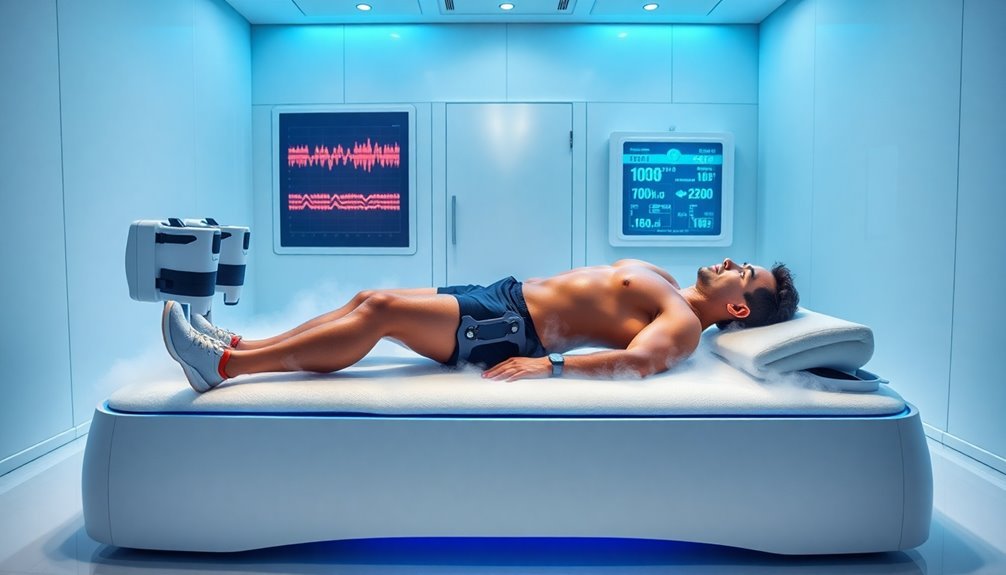
A precise recovery timeline serves as the cornerstone of an athlete's performance optimization strategy. You'll need to think about how different physiological systems recover at varying rates and factor in external commitments like travel and media obligations.
When you're mapping out your recovery windows, remember that they can range from 4 hours between double training sessions to 48 hours during competition periods.
To maximize your recovery effectiveness, you'll want to prioritize the fundamental strategies within specific time windows while accounting for both physical and cognitive stress loads. Building your recovery plan around sleep, nutrition, and hydration creates a solid foundation for more advanced recovery techniques.
- Within 30-60 minutes post-exercise: Focus on immediate nutrition and hydration needs
- First 4 hours: Implement active recovery techniques and cooldown protocols
- 4-24 hours: Prioritize quality sleep and cognitive recovery methods
- 24-48 hours: Integrate sport-specific recovery techniques and monitor readiness metrics
Your recovery timeline should be flexible enough to accommodate individual needs while maintaining structure. You can use wearable technology and data analytics to fine-tune your recovery windows and adjust strategies based on real-time feedback from your body's response to training stress.
Performance Enhancement Strategies
Successful performance enhancement strategies depend on integrating multiple components that work together synergistically. You'll need to focus on four key areas: nutrition, mental preparation, training techniques, and recovery methods to maximize your athletic potential.
Start by optimizing your nutrition through a balanced diet tailored to your specific needs. You'll want to guarantee proper hydration and time your nutrient intake around training sessions, especially post-exercise when your body's primed for recovery.
Complement this with mental strategies like visualization and positive self-talk to build confidence and improve performance.
Your training approach should include structured plans with regular variation to prevent plateaus. You'll benefit from incorporating cross-training activities and using biomechanics analysis to refine your technique. Track your performance metrics to make data-driven adjustments to your training routine.
Don't overlook recovery – it's vital for performance enhancement. You should prioritize 8-9 hours of quality sleep, implement active recovery sessions, and use techniques like hydrotherapy and compression therapy.
Remember to schedule rest days to allow your body to adapt to training demands and prevent overtraining.
Frequently Asked Questions
How Often Should Recovery Systems Be Used to Avoid Overreliance?
You should use recovery systems 2-3 times per week after intense workouts, while maintaining 1-2 complete rest days. Don't rely on them daily, and always prioritize natural recovery like sleep and nutrition.
Can Multiple Recovery Devices Be Safely Used During the Same Session?
You can safely use multiple recovery devices in one session, but you'll need to follow proper protocols, avoid overheating, and consider device compatibility. Always prioritize safety and consult professionals for guidance.
Do Recovery Systems Work Differently for Different Body Types and Ages?
While recovery systems work similarly across ages, they'll have varying effects based on your body type. You'll need to adjust intensity and duration to match your specific build and recovery needs.
What Are the Potential Risks of Using Recovery Systems Before Competition?
You'll risk premature muscle activation and fatigue if you use recovery systems too close to competition. It can disrupt your body's natural pre-event state and potentially decrease your performance readiness and competitive edge.
How Do Recovery Systems Affect Medication Absorption and Effectiveness?
You don't need to worry about recovery systems affecting your medication absorption, as there's no direct evidence they impact drug uptake. However, you should time your medications separately from recovery sessions for maximum effectiveness.
In Summary
You'll find pro-level recovery is no longer limited to elite training facilities. Whether you choose red light therapy, compression boots, or any other cutting-edge recovery system discussed, you're now equipped to make an informed decision. Start with one device that fits your needs and budget, track your results, and adjust accordingly. Remember, your recovery is just as vital as your training for peak performance.

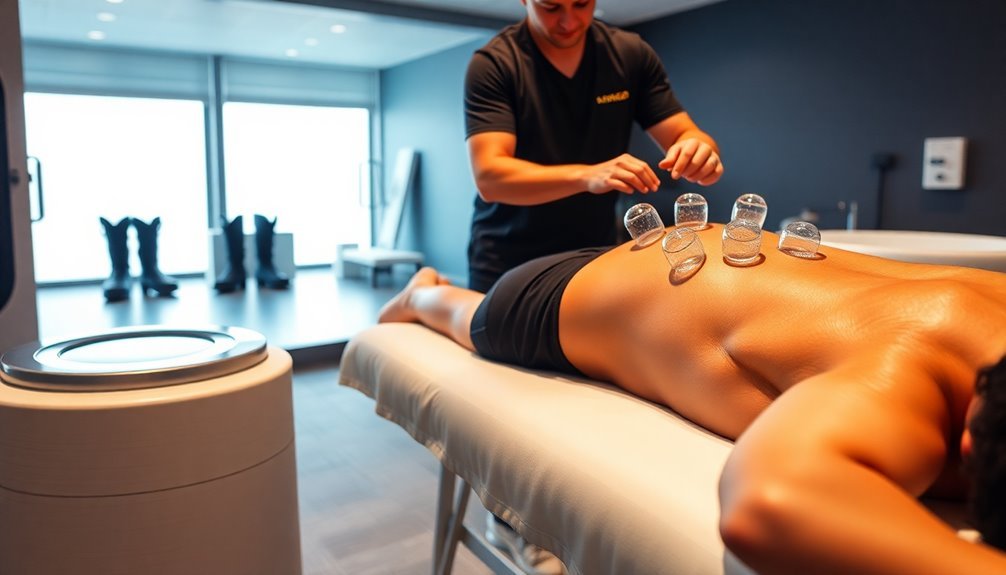



Leave a Reply